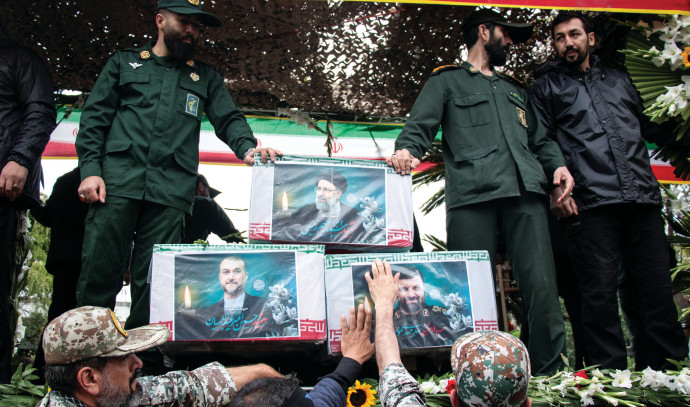The Middle East appears to be perpetually at a crossroads.
Several years ago, from 2017-2019, the region was on the verge of defeating ISIS and emerging from decades of extremism. At the time, it seemed that Iran and Turkey were ascendant and that the Arab states would have a hard time righting their ships of state to emerge more powerful. Then came the Abraham Accords, then came Oct. 7.
This proves we never know what may come next and that making predictions is a precarious endeavor.
With that in mind, it’s worth noting that on May 19, Iranian president Ebrahim Raisi and a team of officials, including Iranian foreign minister Hossein Amir-Abdollahian, flew to northern Iran’s border with Azerbaijan for an important meeting.
They were meeting Azerbaijan’s president and other counterparts of the Iranian officials to see a new dam. This was a significant infrastructure project, part of Tehran’s investment in such projects with its neighbors. Raisi seemed to have been pleased, boarding a helicopter with his foreign minister and the officials afterward to head back to the Iranian capital.
But the pilot decided instead to take a risky journey over mountains near the border as fog closed in. Visibility would have dropped. The aging helicopter may not have had the right type of instruments or warnings, as it flew into a mountainside.
The death of Raisi and his powerful foreign minister could change things in the region.
The death of other leaders in plane crashes have sometimes had important ramifications, such as when a plane with Rwandan president Juvénal Habyarimana and Burundian president Cyprien Ntaryamira was shot down with a missile in 1994, leading to the Rwandan genocide in which at least half a million Tutsis were murdered.
The death of Raisi likely won’t have such major consequences. He will be replaced by some other person, and the system of which he is a part will continue to function. Iran has been hollowed out in recent years by the Islamic Revolutionary Guard Corps, such that the country now functions as a kind of warehouse for the IRGC as it expands across the region like an octopus.
Iran’s recent success
THE WIDER story in the region is that Iran has been successful recently.
It has reconciled with Saudi Arabia, with China’s backing, and it has been seeking to open a new page of ties with Egypt. Tehran also used a recent meeting of Muslim countries in The Gambia to push for more isolation of Israel and more Islamic cooperation. The Islamic Republic basically wants to hijack the region for its needs, using proxies in Lebanon, Yemen, Iraq, and Syria to pursue these goals.
There is very little chance that Iran will be rolled back any time soon. The Gulf countries appear to know that it is now ascendant. They have seen how its backing of Hamas led to Oct. 7 and the resultant massive war. They know that the Houthis in Yemen can be operationalized by Iran to attack their ships and their capitals. Iraq and Syria are hostage to Iran – and there is no balancing force.
In Iraq, the US has forces in the Kurdistan region, but the Kurdish autonomous region is much weaker and more divided than it was several years ago. Iran has achieved this by playing Kurdish political parties against each other and using Baghdad against the Kurdish autonomous capital of Erbil. The US is in northern Iraq ostensibly to continue to fight ISIS, but it is really there to back American forces in Syria. It is not clear how much longer those forces will remain. Former US president Donald Trump tried to withdraw US forces from Syria; if he returns to office, he will likely want to complete the job.
Then there is Syria. Several years ago, the Russians appeared to have the upper hand in Israel’s adversarial northeastern neighbor after they intervened in 2015. However, Moscow attacked Ukraine in 2022 and is now focused on the war there. This has enabled Iran to flourish and expand in Syria. Tehran is also more sensitive now to the Israeli campaign-between-the-wars in Syria, which was launched a decade ago to reduce Iranian entrenchment there.
It is therefore clear that Iran will continue to hollow out Syria and use it as a launching pad to threaten the region, using it to move weapons to Hezbollah in Lebanon and also to threaten US forces. In January, Iranian-backed Kataib Hezbollah in Iraq even launched drones that killed US service members in Jordan.
THERE IS some pushback, however.
These days, the US is training in Jordan alongside other partner countries in a drill called Eager Lion. Among the recent highlights of that American operation have been the deployment of US soldiers alongside Special Operations Forces from Cyprus and Lebanon who have trained together.
Eager Lion brings together 33 nations and improved interoperability among partner-nation militaries. Washington recently said that “the year 2024 marks 75 years of diplomatic relations between the US and the Hashemite Kingdom of Jordan, which hosts this comprehensive exercise biennially.” The US brought M1A1 Abrams tanks to Jordan, and they also fired M121 120mm mortar systems. While all of this is important, Iran is still on the march everywhere else.
For instance, Tehran is now setting the northern West Bank ablaze. It has supported Palestinian extremist groups, such as Palestinian Islamic Jihad, in their efforts to procure and bring in smuggled and stolen weapons. These include stolen M-4/AR type rifles. In addition, Iran is backing Hamas in Gaza and wants to erode the Palestinian Authority in the West Bank and bring Hamas to power there in the next several years. These are pivotal trends because if Israel does not defeat Hamas in Gaza, then Iran will work to bring it to power in the West Bank.
In addition, Hamas leaders are hosted in Qatar and Turkey, two Western allies. This further complicates the region by making instability more likely. Qatar will likely angle for a role in post-war Gaza. It may also angle to bring technocrats into the PA in the West Bank, who will then be revealed to be members of Hamas once they are entrenched in power.
THERE ARE also other trends in the region.
Egypt opposed the Israeli operation in Rafah. It turns out that Hamas likely was able to smuggle or import weapons for years into Gaza via Egypt. This may indicate that behind the scenes, Cairo made some kind of deal to ignore some of this trade in exchange for something – perhaps in exchange for Turkey and Qatar stopping support for the Muslim Brotherhood in Egypt.
Hamas is linked to the Muslim Brotherhood, which Egypt views as a terrorist group. Why would Cairo want Hamas empowered in Gaza but the Brotherhood suppressed at home? Perhaps it was part of a wider regional deal?
Regional deals are the name of the game now. China brokered a deal with Iran and Saudi Arabia; Russia imports Iranian drones; Iran uses its proxies to attack Israel. All of this points to a trend that could give Tehran more power in the region. Several years ago, it was not clear that Iran would have all this power. But it exploited the vacuum left by ISIS in Iraq and Syria. It also exploited the vacuum left by Russia in Syria and the one left by the US reducing its role in the region.
Nature abhors vacuums. Iran has exploited this and fills them to the hilt everywhere it can.







